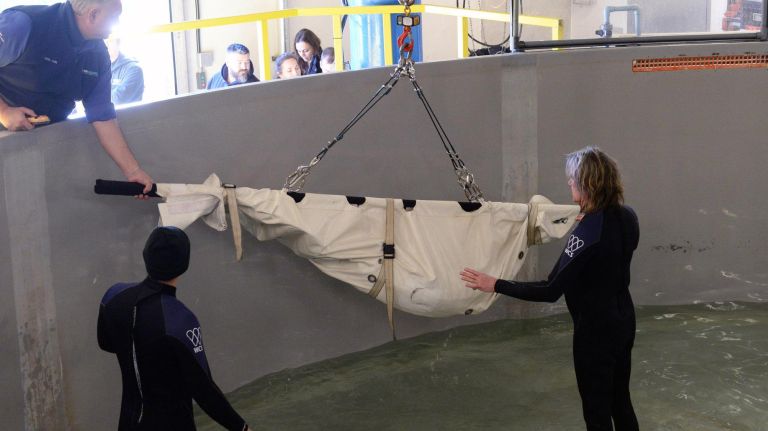
These native New Yorkers are back where they belong.
Five endangered Atlantic sturgeon are now on view at the Wildlife Conservation Society’s New York Aquarium, which was recently designated a satellite research facility by the U.S. Fish and Wildlife Service.
Each of the sturgeon measure more than five feet long and tips the scales at over 100 pounds. They join an awe-inspiring team of sharks, rays and other marine life at the gigantic Canyon’s Edge habitat in the “Ocean Wonders: Sharks!” exhibit.
Sharing the story of these unique, prehistoric-looking fish provides a vital conservation message, said Jon Forrest Dohlin, WCS vice president and director of the New York Aquarium.

Sturgeon, which can live to the age of 60, are known for their longevity. But these sturdy beasts of the river and ocean fell victim to overfishing and habitat degradation, he said.
Only a few of the once-ubiquitous sturgeon shops, which feature smoked fish, caviar and other appetizers, still remain in the city.
“The echoes of their history in New York are so strong because that’s how common and so popular and how core they were to our identity,” said Dohlin. “They were called Albany beef.”
Sturgeon traveled up the Hudson River to spawn, making them an easy target for upstate fisheries.
In the late 1800s, nearly 7 million pounds of meat were taken from sturgeon as well as the precious caviar made from their eggs. By about 1905 that number was down to 20,000 pounds, Dohlin said.
“Ship strikes were also a big problem,” he said.
By 2012, the once-plentiful Atlantic sturgeon that dates back to the time of the dinosaurs, was listed as endangered in the United States.
Scientists and researchers at the Wildlife Conservation Society jumped at the chance to house five Atlantic sturgeon that were part of a breed and release program at the Cooperative Oxford Laboratory in Maryland. The lab, operated by the Maryland Department of Natural Resources and the National Oceanic and Atmospheric Administration needed a home for five of the sturgeon they were not allowed to release.
“These animals are genetically typed,” Dohlin said, “We know they are from the New York Bight. In the wild, they would be coming up and down the Hudson River.”
The Bight, the seascape that extends from Montauk at the end of Long Island to Cape May at the southern tip of New Jersey, boasts a rich and diverse ecosystem.
On Wednesday, a team of WCS curators and animal keepers moved the sturgeon from the holding tank where they had been waiting out their quarantine into the 613,000 gallon Canyon’s Edge.
It was a delicately choreographed scene designed to reduce stress on the animals.
Many of the staffers, including Hans Walters, animal department supervisor for the aquarium, donned wet suits so they could enter the tanks.
Others helped from above, operating a crane that carefully lifted the sturgeon in smaller water-filled transport boxes that were set on a truck so they could undergo a medical check and then a brief ride to the “Ocean Wonders: Sharks!” building.
Dave DeNardo, general curator for the aquarium, supervised every step of the transfer. One by one, the sturgeon were brought to their new home, already populated with rays, sharks, fish and a sea turtle.
The Canyon’s Edge is designed to show the diverse marine life seen in the waters of the Atlantic Ocean’s Hudson Canyon, located about 100 miles from the city limits.
Of the 27 known species of sturgeon, about half are considered “critically endangered” according to WCS officials.
The age of the five sturgeon is not clear but they are on the young side, officials said. A fully-grown Atlantic sturgeon can span 14 feet and weigh up to 800 pounds.
“They are impressive fish, they look ancient,” Dohlin said, noting the bony plates that cover their bodies. “You are staring into timeless eyes when you look at them.”
Dohlin said having sturgeon on display at the aquarium is an honor and an “incredible opportunity” to inspire people and support efforts to conserve them.
“You don’t get to see them in the rivers or the aquariums anymore because of their [endangered] status,” he said. “
Their story speaks to the pressures put on wildlife and their habitats, and the resulting damage. But Dohlin is hopeful for their future, as New Yorkers have worked hard to reclaim their waterfront by replacing industrial sites with new parks and recreation facilities.
“There has been a change in our mindset from exploitation to treasure, now everyone wants to walk along the water, play on the water … they want to live within sight of it,” Dohlin. “What we are striving to do on the wildlife end is to preserve a thriving and healthy water-based ecosystem. So we are all working together toward that goal.”




































